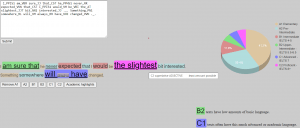EnglishGrammar.Pro has the only CEFR grammar profiler on the internet. It links highlighted grammar to corpus frequency lists, and learner or expert examples. In this way, it presents the grammar and vocabulary that go together most often (colligation) with authenticity. It can help ESL teachers mark learner texts by positively highlighting the most complex features, edit authentic reading materials to the appropriate level, and locate features for a FOCUS on FORM segment of a lesson. The language inventory that our text inspector uses can also be accessed through these CEFR level links:

English structures for the Guru
English Grammar Pro shares what ESL teachers don’t usually get. That is the ability for them to do their own grammar searches on the texts they teach from or those written by their students. Each grammar point presented, contains a regular expression to find forms tagged with Lancaster University’s CLAWS 7 tagset. This is used by corpora like iWeb corpus, and the automatic tagger can tag your own texts too. In addition to expanding the EGP grammar structures in expert corpora, we’ve also confirmed the levels of the grammar given by resources such as the EGP in other large learner corpora. The University of Pittsburgh English Language Institute Corpus (PELIC) provides yet more real evidence of the types of language students produce in writing classes, and the Trinity Lancaster Corpus (TLC) gives us examples of what students can do in speaking tests. Our tool for corpus linguistics is built on the tests we run against these corpora.
